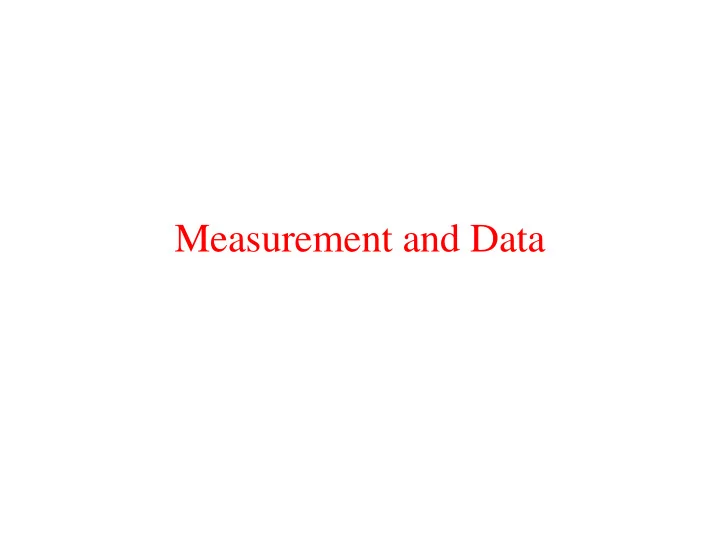

Measurement and Data
Data describes the real world • Data maps entities in the domain of interest to symbolic representation by means of a measurement procedure • Numerical relationships between variables capture relationships between objects • Measurement process is crucial
Types of Measurement • Ordinal, e.g., excellent=5, very good=4, good=3… • Nominal, e.g., religion, profession – Need non-metric methods • Ratio, e.g., weight – has concatenation property, two weights add to balance a third: 2+3 = 5 – changing scale (multiplying values by a constant) does not change ratio • Interval, e.g., temperature, calendar time – Unit of measurement is arbitrary, as well as origin
Distance Measures • Many data mining techniques (e.g., nn- classification, cluster analysis) are based on similarity measures between objects • s(i,j): similarity, d(i,j): dissimilarity • Possible transformations: d(i,j)= 1 – s(i,j) or d(i,j)= sqrt (2*(1-s(i,j))
Metric Properties 1. d(i,j) > 0: Positivity 2. d(i,j) = d(j,i): Commutativity 3. d(i,j) < d(i,k)+d(k,j): Triangle Inequality
Euclidean Distance between vectors 1 / 2 = ∑ p ( ) − 2 ( , ) d x y x y E k k = 1 k
Commensurability • Euclidean distance assumes variables are commensurate • E.g., each variable a measure of length • If one were weight and other was length there is no obvious choice of units • Altering units would change which variables are important
Standardizing the Data • Divide each variable by its standard deviation • Standard deviation for the k th variable is 1 1 ∑ 2 σ = − µ 2 ( ( ) ) x i k k k n = 1 i where n 1 ∑ µ = ( ) x i k k n = 1 i
Weighted Euclidean Distance • If we know relative importance of variables 1 = ∑ p 2 − 2 ( , ) (( ( ) ( )) d i j w x i x j WE k k k = 1 k
Need for Covariance in distance measure • Suppose we measured a cup’s height 100 times and diameter only once • Clearly height will dominate although 99 of the height measurements are not contributing anything • They are very highly correlated • To eliminate redundancy we need a data- driven method
Sample Covariance between X and Y = ∑ n 1 _ _ − − ( , ) ( ) ( ) Cov X Y x i x y i y n = 1 i • Measure of how X and Y vary together • Large positive value if large values of X tend to be associated with large values of Y and small values of X with small values of Y • Large negative value if large values of X tend to be associated with small values of Y
Correlation Coefficient Value of Covariance is dependent upon ranges of X and Y Removed by dividing values of X by their standard deviation and values of Y by their standard deviation _ n _ ∑ − − ( ( ) )( ( ) ) x i x y i y ρ = = 1 i ( , ) X Y σ σ x y
Correlation Matrix
Mahanalobis Distance 1 ( ) ∑ − 1 = − − T ( , ) [ ( ) ( ) ( ( ) ( )) ] 2 d i j x i x j x i x j M
Generalizing Euclidean Distance • Minkowski or L ? metric 1 λ p ( ) ∑ λ − ( ) ( ) x i x j k k = 1 k • ? = 2 gives the Euclidean metric
Minkowski metric • ? = 1 is the Manhattan or city block metric p ∑ − | ( ) ( ) | x i x j k k = 1 k • ? = infinity yields − max | ( ) ( ) | x i x j k k k
Mutivariate Binary Data • Most obvious measure is Hamming Distance normalized by number of bits + S S 11 00 + + + S S S S 11 10 01 00 • If we don’t care about irrelevant properties had by neither object we have Jaccard Coefficient S 11 + + S S S 11 10 01 • Dice Coefficient extends this argument. If 00 matches are irrelevant then 10 and 01 matches should have half relevance
Some Similarity/Dissimilarity Measures for N-dim Binary Vectors * * * where
Some Similarity/Dissimilarity Measures for N-dim Binary Vectors * * * where
Weighted Dissimilarity Measures for Binary Vectors • Unequal importance to ‘0’ matches and ‘1’ matches • Multiply S 00 with ß ([0,1]) + β ⋅ • Examples: S S = − D sm 11 00 1 (X,Y) N − − β ⋅ 2 ( ) N S S = D rta 11 00 ( , ) X Y − − β ⋅ 2 N S S 11 00
Transforming the Data
V 1 is non-linearly Related to V 2 V 2 V 1 V 3 =1/V 2 is linearly related to V 1
Variance increases (regression assumes variance is constant) Square root transformation keeps the variance constant
Form of Data
Data Matrix • A set of p measurements on objects o(1)…o(n) • n rows and p columns • Also called standard data , data matrix or table
Multirelational Data • Payroll database has – Employees table: name, department-name, age, salary – Department table: department-name, budget, manager • The tables are connected to each other by the department-name field and the fields name and manager • Can be combined together, e.g., with fields name, department-name, age, salary, budget, manager • Or create as many rows as department-names • Flattening may require needless replication of values
Data Quality
Outlier
Recommend
More recommend